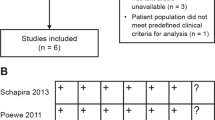Abstract
Objective
To evaluate the efficacy of Chinese medicine (CM) adjunct to conventional medications for idiopathic Parkinson’s disease (PD).
Methods
Electronic English and Chinese databases including PubMed, Cochrane Library, Web of Science, Chinese Medical Current Contents, China National Knowledge Infrastructure, China Science and Technology Journal Database, Wanfang Med Database, and Traditional Chinese Medical Database System were used for key words searching in a highly sensitive search strategy. The extracted data was analyzed by the Review Manager 5.0.
Results
Twelve trials involving 869 participants were included in the meta-analysis. Unified PD Rating Scale (UPDRS) I, II, III, IV scores and UPDRS V–IV total scores were used to be the primary outcomes, Parkinson Disease Question-39 (PDQ-39) and Scores of Chinese Medical Symptoms were the secondary outcomes. CM adjunct therapy had greater improvement in UPDRS I [2 trials; standardized mean difference (SMD)–0.40, 95% confidence interval (CI)–0.71 to–0.09; Z=2.49 (P=0.01)], II [5 trials; SMD–0.47, 95% CI–0.69 to–0.25; Z=4.20 (P<0.01)], III [5 trials; SMD-0.35, 95% CI–0.57 to–0.13; Z=3.16 (P=0.002)], IV scores [3 trials; SMD-0.32, 95% CI–0.60 to–0.03; Z=2.17 (P=0.03)], UPDRS I–IV total scores [7 trials; SMD-0.36, 95%CI–0.53 to–0.20; Z=4.24 (P<0.05)]. PDQ-39 and Chinese medical symptoms compared to the conventional medication only.
Conclusion
CM adjunct therapy has potential therapeutic benefits by decreasing UPDRS scores and reducing adverse effect.
Similar content being viewed by others
References
Nussbaum RL, Ellis CE. Alzheimer’s disease and Parkinson’s disease. N Engl J Med 2003;348:1356–1364.
Rao SS, Hofmann LA, Shakil A. Parkinson’s disease: diagnosis and treatment. Am Fam Physic 2006;74:2046–2054.
Williams GR, Kurland LT, Goldberg ID. Morbidity and mortality with parkinsonism. J Neurosurg 1966;24:138–143.
Ronald FP, Zbigniew KW, Manuchair E. Parkinson’s disease. Boca Raton: CRC Press; 2013:135–138.
Rajendran PR, Thompson RE, Reich SG. The use of alternative therapies by patients with Parkinson’s disease. Neurology 2001;57:790–794.
Hughes AJ, Daniel SE, Kilford L, Lees AJ. Accuracy of clinical diagnosis of idiopathic Parkinson’s disease: a clinico-pathological study of 100 cases. J Neurol Neurosurg Psychiatry 1992;55:181–184.
Wang XD. Standard for diagnosing and distinguishing Parkinson’s disease and Parkinsonian syndromes. J Nerv Ment Dis (Chin) 1985;18:256–257.
Writing Group of the Movement Disorders and Parkinson’s Disease Society of Neurology Committee of Chinese Medical Association. The diagnosis of Parkinson’s disease. Chin J Neurol 2006;39:408–409.
Fahn S, Elton RL, Members of the updrs Development Committee. Recent developments in Parkinson’s disease. Macmillan Health Care Informat 1987;2:153–163,293-304.
Tsang KL, Chi I, Lou VW, Chu LW, Ho SL, Lee TM. Translation and validation of the standard Chinese version of PDQ-39: a quality of life measure for patients with Parkinson’s disease. Mov Disord 2002;17:1036–1040.
Long CX. Standard for diagnosis and curative effect of Chinese medical symptom of senile tremor. J Beijing Instit Tradit Chin Med (Chin) 1992;15:39.
Cui L, Yu XD, Cui J. Clinical observation on effect of combined therapy of Bushen Pingchan Recipe and Medopa Tablet in treating Parkinson’s disease. Chin J Integr Tradit West Med (Chin) 2003;23:504–507.
Jin RG. Efficacy and the underlying mechanism of traditional Chinese formula Naokangning in patients with Parkinson’s disease. Jinan: Shandong Univ Chin Med (Disssertation, Chin) 2004.
Li JY. Clinical research on the treatment of Parkinson’s disease with strengthening Kidney and activating circulation by Prof. Zhao Guan-ying. Beijing: Chinese PLA General Hospital and Postgraduate Medical School (Dissertation, Chin) 2009.
Li JY, Shi H, Chen MN, Tang M, Yang XL. Influence of therapy of strengthening Shen and activating circulation on life quality of rigid type Parkinson’s disease patient. Prac J Med and Pharm (Chin) 2012;29:388–390.
Liu YF. Clinical research of treating hypokinesia type and rigid type Parkinson’s disease with Mafuxin Decotion. Guangzhou: Guangzhou Univ Chin Med (Dissertation, Chin) 2012.
Ma L. Treatment of Parkinson’s disease of 40 cases with Xifeng Zhengchan Recipe. Chin Med Res (Chin) 2008;21:39–41.
Wang DG, Lu ZY, Zhao H. Clinical trial of Bushen Yanggan Xifeng Decoction on Parkinson’s disease with yin deficiency of Gan and Shen. Liaoning J Tradit Chin Med (Chin) 2012;39:1462–1465.
Xiao XL. Clinical research on reinforeing Kidney and activating blood circulation treatment in parkinson disease. Guangzhou: Guangzhou Univ Chin Med (Dissertation, Chin) 2010.
Zhong C, Huang P, Shun ZG. Clinical effect of Bushen Huoxue Tongluo capsule on 120 cases with Parkinson’s disease. Chin J Experim Tradit Med Formul (Chin) 2012;18:343–346.
Kum WF, Durairajan SSK, Bian ZX, Man SC, Lam YC, Xie LX, et al. Treatment of idiopathic Parkinson’s disease with traditional chinese herbal medicine: a randomized placebocontrolled pilot clinical study. eCAM 2011;18:1–8.
Yu XD, Cui L, Chen B. Quantitative evaluation of selfmade Bushen Pingchan Formula combined with madopar for Parkinson’s disease. Chin J Clin Rehabilit (Chin) 2006;35:160–162.
Yuan CX, Ye Q, Wang J, Zhang Y, Yuan CG. Effects of traditional Chinese herbal medicine on the neurobehavioral manifestations and the activity of dopamine D2 receptor in corpora striatum of rats with levodopa-induced dyskinesias. J Chin Integr Med (Chin) 2008;10:1024–1028.
Lo YC, Shih YT, Tseng YT, Hsu HT. Neuroprotective Effects of San-Huang-Xie-Xin-Tang in the MPP(+)/MPTP models of Parkinson’s disease in vitro and in vivo. eCAM 2012;2012:501032.
Wang H, Li WW, Cai DF, Yang R. Protecting effect of Cistanche extracts on MPP+-induced injury of the Parkinson’s disease cell model. J Chin Integr Med (Chin) 2007;4:407–411.
Ernst E, Lee M. A trial design that generates only "positive" results. J Postgradate Med 2008;54:214–216.
Schulz KF, Altman DG, Moher D. CONSORT 2010 statement: updated guidelines for reporting parallel group randomised trials. Int J Surg 2011;9:672–677.
Wu TX, Li YP, Bi ZX. Consolidated standards for reporting trials of traditional Chinese medicine (CONSORT for CM) (for solicitation of comments). Chin J Evid Based Med 2007;7:625–630.
Author information
Authors and Affiliations
Corresponding author
Additional information
Supported Chen Keji Integrative Foundation (CKJ2015004), Foundation of Fujian University of Traditional Chinese Medicine (X2014010-xueke), and the Scientific Research Fund of the National Health and Family Planning Commission of the People’s Republic of China (No.WKJ-FJ-38)
Electronic supplementary material
Rights and permissions
About this article
Cite this article
Wei, W., Chen, Hy., Fan, W. et al. Chinese medicine for idiopathic Parkinson’s disease: A meta analysis of randomized controlled trials. Chin. J. Integr. Med. 23, 55–61 (2017). https://doi.org/10.1007/s11655-016-2618-7
Received:
Published:
Issue Date:
DOI: https://doi.org/10.1007/s11655-016-2618-7




